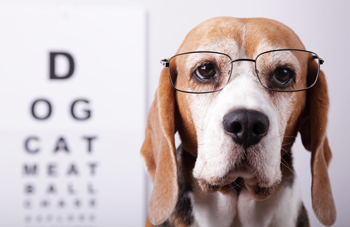Progressive Retinal Atrophy: PRA in Dogs

Progressive retinal atrophy, or PRA, is a disease that causes degeneration of a dog's retina over time. The retina is responsible for collecting light and transmitting messages through the optic nerve to the brain, which processes them into sight.
Degeneration of the retina negatively affects vision. Dogs with PRA also tend to develop a specific type of cataract (toxic cataract), which further impedes their ability to see.
Cause of Canine PRA
Progressive retinal atrophy in dogs is genetic. It is a recessive gene, so both parents must carry it for the offspring to have it.
There are several forms of PRA because it is actually a group of diseases, but they all affect the retina's ability to detect and/or process light.
Signs of PRA in Dogs
Signs of PRA can be difficult to notice because they tend to be gradual.
Usually, a dog's night vision is diminished and lost first when he has PRA, then he loses dim light vision, then bright light vision. Owners may have difficulty identifying that there is a problem until it is quite advanced because the signs can be subtle and come on slowly.
Breeds Most Commonly Affected by PRA
There are many breeds that are prone to different forms of PRA. Some are affected by early onset disease before they are six months old. Others have a form that strikes later on, usually between three and five years of age.
Some breeds that are more commonly diagnosed with PRA include:
- Collies
- Irish setters
- Akitas
- Dachshunds
- Samoyeds
- Cocker spaniels
- Miniature Schnauzers
Diagnosis of Canine PRA
Your general veterinarian will perform a basic eye examination if a vision problem is suspected. He or she may then refer you to a veterinary ophthalmologist for more in-depth testing. An electroretinogram (ERG) test is necessary to properly diagnose PRA.
Treatment of Progressive Retinal Atrophy in Dogs
There is no specific treatment for PRA. If toxic cataracts form, their removal can help preserve the dog's sight longer. Certain vitamin and/or antioxidant therapies are recommended by some veterinarians, but there is no real indication that these slow down or stop the disease process.
It's important to help your dog adapt to his vision loss. Most dogs cope with PRA well because its progressive nature allows them to adjust gradually.
When your dog is blind, you can help him by not moving furniture around, keeping pathways that he uses to move throughout the house clear, and keeping him leashed while outside.
Keep stairways blocked off with a child safety gate so your dog can't fall down them, and similarly, block off any other dangerous areas of your home. Cushion sharp furniture edges with baby safety covers.
Keep your dog as active as you can so he maintains a good weight and great quality of life. As your dog adjusts to his vision loss, he will be able to do more things.
Prevention of PRA in Dogs
PRA is a genetic condition, so it's important not to breed dogs that are affected by it. If you are adopting a purebred dog, be sure that the parents were certified by a veterinary ophthalmologist as not having the disease.
Learn more about other canine eye problems here: "Common Eye Conditions in Dogs."You May Also Like These Articles:
A General Guide to Puppy Safety
Canine Epilepsy: Seizures in Dogs
Restrain Your Dog While Driving
A Hidden Laundry Room Danger for Dogs: Laundry Pods
Things We Do That Annoy Our Dogs - Slideshow
Quiz - Test Your Cold Weather Dog Knowledge
Disclaimer: This website is not intended to replace professional consultation, diagnosis, or treatment by a licensed veterinarian. If you require any veterinary related advice, contact your veterinarian promptly. Information at DogHealth.com is exclusively of a general reference nature. Do not disregard veterinary advice or delay treatment as a result of accessing information at this site. Just Answer is an external service not affiliated with DogHealth.com.
Notice: Ask-a-Vet is an affiliated service for those who wish to speak with a veterinary professional about their pet's specific condition. Initially, a bot will ask questions to determine the general nature of your concern. Then, you will be transferred to a human. There is a charge for the service if you choose to connect to a veterinarian. Ask-a-Vet is not manned by the staff or owners of DogHealth.com, and the advice given should not delay or replace a visit to your veterinarian.



